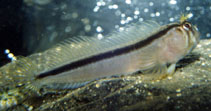| Family: |
Blenniidae (Combtooth blennies), subfamily: Salariinae |
| Max. size: |
8 cm TL (male/unsexed) |
| Environment: |
benthopelagic; marine; depth range 1 - 3 m |
| Distribution: |
Southwest Pacific: New South Wales in Australia, New Zealand, and Kermadec Islands (Ref. 8879). |
| Diagnosis: |
|
| Biology: |
Adults inhabit clear coastal reefs, on vertical rock faces with narrow cracks and sea urchins (Ref. 9002). They feed by browsing on copepods, mollusk eggs and hydroids on the bottom (Ref. 26966). Oviparous. Eggs are demersal and adhesive (Ref. 205), and are attached to the substrate via a filamentous, adhesive pad or pedestal (Ref. 94114). Larvae are planktonic, often found in shallow, coastal waters (Ref. 94114). |
| IUCN Red List Status: |
Least Concern (LC); Date assessed: 27 March 2009 Ref. (130435)
|
| Threat to humans: |
harmless |
Source and more info: www.fishbase.org. For personal, classroom, and other internal use only. Not for publication.

